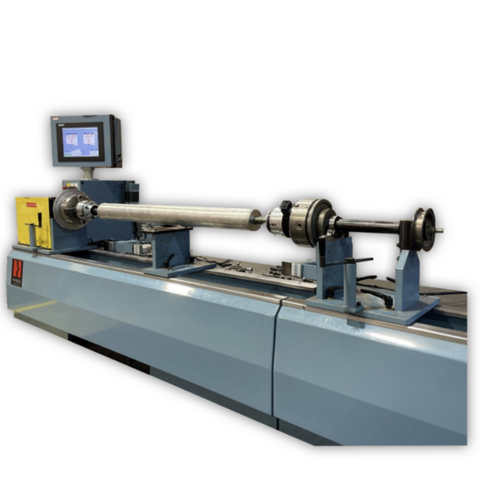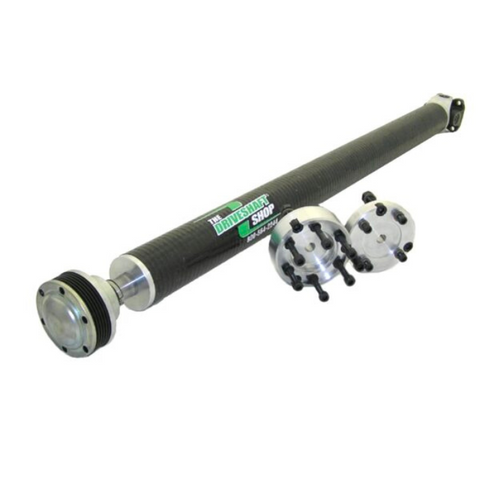Driveshafts/Tailshafts 101

The DriveShaft shop is proud to now offer a high-speed balancing service. Over the years they have been faced with the question that almost every balancing machine available raises. “How fast is the Driveshaft/Tailshaft balanced for?” Most balancing machines are very efficient in doing the job that they are designed for, as long as they are calibrated and working properly.
Instead of actual shaft speed, they rely on sensors that detect the “weight centreline” of the part being spun. This means that when the shaft is spinning, the machine is seeing how far out of the centre the weight is.
Then goes on to indicate what amount of weight is needed to bring it within a certain tolerance. But not all Driveshaft/Tailshaft applications are the same and depending on what the Driveshaft/Tailshaft is going to be used for, some will need to have a more detailed approach to balancing.
That being said, when the shaft is being spun at the actual speed that it will be running at, it presents more information to assimilate and therefore gives the ability to accurately correct it. Another major advantage is that a high-speed balancer will also be able to analyze parameters that the slow-speed machine cannot. Such as u-joint tolerance, tube flex, harmonic resonance, slip yoke instability, and more.
With this new machine, they can spin a 17lb shaft to actual speeds of over 9000 RPM. Most Driveshaft/Tailshaft balancers only spin from 400-3000 RPM (most average about 1000 RPM). This machine was custom-made for The DriveShaft Shop and high-speed balancing is offered as a separate service, only from The DriveShaft Shop.

DRAG RACING AND STREET DRIVESHAFTS/TAILSHAFTS
When a company has been around for 30+ years things are into a certain perspective. Either you get old with the rest of the pack or you grow and learn on a constant basis. At The Driveshaft Shop, they grow and learn every day. Being involved in the racing industry since the early ’70s, they remember the days on Long Island when Motion Performance was a local shop. Drag racers stopped by on a regular basis (and they’re still there). National Speedway was the place to go, and those were simpler times.
They understand cars and the unique challenges involved in making a racing shaft today. Back in the ’70s, it was simple. Just use a truck tube and some good joints and you have a race shaft. Technology has changed and so has The Driveshaft Shop. With today’s higher HP/Torque motors, higher RPM drive trains, and sophisticated suspensions you need to know what you’re doing to make a shaft today.
They manufacture Driveshafts/Tailshafts in standard Carbon steel, Chromoly, Carbon fibre, or 6061-T6 aluminum. All of their carbon steel and Chromoly shafts are welded to their demanding specs using their unique slow feed lathe mounted welders using a special powdered core wire that has a higher tensile strength than conventional welding.
Every shaft is balanced on their state-of-the-art computerized two-plane balancers and weights are attached with their special rivet-type mounts. All this is great. But before any shaft is made, they carefully make sure the shaft is designed to spec before they manufacture it. They feel at a higher level of competition cars, they need to talk to you and give you a personal assessment of the car to assure its proper part.
They will need to know the following:
- HP/Torque of the motor
- Transmission
- Rear Ratio
- Rear tyre size and height
- Top MPH the car will see
- Weight of the car with driver
With this info, they will be able to check for overall strength, critical speed, and durability needed. All shafts are hand-made in their North Carolina facility and carefully packed for shipping within 2-3 days. If you’re looking for a racing shaft give contact us and let us assist you to build a custom Driveshaft/Tailshaft for your application.
To check for critical speed, calculate this equation below:
Top speed x 336 (a constant) x rear ratio (like 4.10), then divide it by the tire height (28” tall tire).
Here is an example:
Top speed is 160mph x 336 = 53760 x rear ratio of 4.10 = 220416, then divide this number by the tire height, 28”. This car would have a top RPM of 7872. Now the shaft is designed will need to be able to do this RPM.
STREET ROD DRIVESHAFTS/TAILSHAFTS
Street rods are not foreign to The DriveShaft Shop, everyone in their building is into some sort of car. They manufacture Driveshafts/Tailshafts from simple Carbon Steel, Chromoly and finish up the lineup with 6061-T6 Aluminum. These shafts can be made in any style or arrangement. Where they differ from most companies is that they have an understanding of the entire car.
Let’s start with a simple problem. John Knuclebuster has installed a 350/750R in his 47 Chevy and has a vibration when stepping on the gas. He has brought the shaft back to the shop he purchased it from several times only to be told the shaft is balanced. Guess what, it more than likely is! A friend of Mr. Knuclebuster checks the pinion angle and tells him it’s correct. What was missed was the front and rear angle which has no more than four degrees of operation. Simple, right? Not really. Due to the 700R sitting so high in the tunnel he can’t get it higher to correct the angle. The solution is a C.V. on the front of the shaft (which can be made for just about any car). The story is kind of corny but they have been around for years and hear stories like this over and over. Not only can they make the best shaft for the car, but if there is a problem they will stay with it until the end. Professional drivetrain people doing what they love, making parts.
So, if you’re doing a simple 350/350 in your three windows or have decided to put a C5 drive train under your 37 (they can build CV axles too) please contact us and we can assist you with all things The Driveshaft Shop.
DRIVESHAFT/TAILSHAFT VIBRATION: 101 (Not for CV Axles)
Most people have trouble determining if the vibration in their vehicle is coming from the DRIVESHAFT or not. There are typically two types of vibration most vehicles would have. A fast cycle vibration or a slow cycle vibration. Try the test if you’re not sure. To help understand this let’s say we put a bucket of water on the passenger’s floor. If the vibration in the vehicle produces small ripples on the top of the water this would be considered a fast cycle vibration. This type of vibration is usually a drive train vibration, things like the driveshaft, motor, or torque converter. If the vibration puts waves on the top of the water or splashes, this type of vibration is a slow cycle vibration and usually is an axle or tire vibration and not from the driveshafts.

